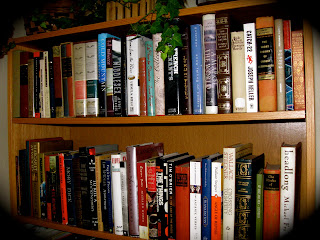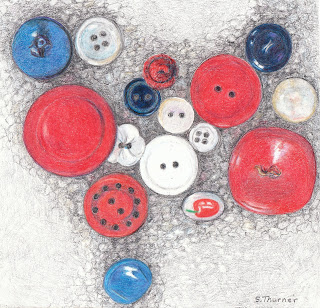
I participate in a couple online book groups, and a local group. These folks give me lots of ideas of books to read, so many in fact that in 2009 I imposed an 500 page limit upon myself. I try to read a combination of fiction and nonfiction, and I like to do some re-reading of books I read when I was in high school and college, just to see if I can get more out of them now. I usually do. I also enjoyed reading some children's classics that I somehow missed before, and these were a delight as well. It's probably silly to list an arbitrary ten books, when I read so many (over a hundred, including some books of poetry and some drama), but I do it every year. I didn't include any art books, or books I was reading a second or third time. For better or worse, here goes:
Affinity - Waters, Sarah
The setting is Victorian London. There are two female leads, Margaret Prior, a nervous, pale, and unhappy girl who decides to visit lady prisoners at Millbank Prison after the death of her father. The other principal character is one of those prisoners, Selina Dawes, a spiritualist convicted of causing the death of her patron. This is in many ways a classic gothic novel, complete with creepy settings, mourning for lost loves, ghosts (maybe), and an undercurrent of passion. The story unfolds in chapters that alternate between Margaret's diary and Selina's. Waters never fails to pen page turners, and this one had me up late, anxious to see how the tangled web of the plot unraveled itself. The plot has more twists than London streets, a real pleasure.
Elegance of the Hedgehog, The - Barbery, Muriel
I wasn't keen to read this novel, chosen by my local book group, but I'm glad I did. I enjoyed the two protagonists, both of these bright outsiders, use their intellect as a sort of defensive shell, and each learns something from one another. The young girl reminds me a little of Holden Caulfield in
Catcher in the Rye. Some of my group were put off by the discussions of philosophy, but others (including myself) found this to be a satisfying novel.
Evidence of Things Unseen - Wiggins, Marianne
I never wrote a review, so I stole this from the Amazon site. This novel was a discovery, one I will remember for a long time. Maybe one reason was that I read it right before I visited the Hanford site in Washington state. In 1911 or so my grandmother attended elementary school there.
In Evidence of Things Unseen, Ray Foster's passion is light, whether bioluminescence, starlight, or X-rays. He returns home from World War I and falls in love with Opal, seeing her for the first time through her father's glass blowing tube. Ray's best friend from the war, Flash, gets in trouble and Ray and Opal are forced to move to Tennessee. Ray gets a job with the TVA and takes a portable X-ray machine to county fairs to show people the bones in Opal's feet, and eventually works on the atomic bomb project at Oak Ridge. It is this passion for things unseen that eventually brings tragedy to their lives, and harbors ill for all of humanity.Graveyard Book, The - Gaiman, Neil
I heard good things about Neil Gaiman's
The Graveyard Book, and for once the hype was justified. This YA novel appealed to this not-so-young reader very much indeed. The plot combines a murder mystery with a charming story of a boy raised by (nope not wolves) ghosts. A sort of Jungle Book of the graveyard. It begins with an English family of four, and three are killed. The baby, later called Nobody (Bod) Owens, is raised, taught and guarded from harm by the spirits of the departed. There is humor, action, and suspense. Great fun.
In Defense of Food - Pollan, Michael
The book has three main sections: The Age of Nutritionism, The Western DIet and Diseases of Civilization and Getting Over Nutritionism. There is also a good list of sources and resources for further reading. In the first section he defines nutritionism and casts doubt on much scientific research since World War II, especially Western society's low-fat craze. It had me remembering various "food pyramids" I studied in 4-H and high school classes, and wondering how much was at least wrong, or at worst harmful. He suggests that science does not completely understand what nutrients and micronutrients are necessary for health, and certainly does not understand the symbiotic relationships among nutrients. If it did, Americans would not be suffering from disease and obesity as much as they are. In the last section he makes some general suggestions for more healthful eating. Eat food, preferably something your great grandmother would recognize as food. Avoid foods with unfamiliar or unpronounceable ingredients - including high fructose corn syrup. Avoid products that make health claims. Shop the outside of the market and avoid the center where the highly processed foods lurk. If possible shop at farmers markets, or garden and grow some of your own food. Eat mostly plants, especially leaves. Popeye was right. eat wild foods when you can. Eat more slowly. Have a glass of wine.
Reservation Blues - Alexie, Sherman
At the beginning of
Reservation Blues, Simon, an Indian who only drives backward (?!), notices a black man with a guitar by the side of the road. Is he lost? The solitary man turns out to be blues legend Robert Johnson, who acquired his prodigious musical talent through a deal with the devil. In the course of the story the cursed guitar passes on to the geeky and sweet Indian storyteller, Thomas Builds-the-Fire. Thomas, who is friends with two other Spokane Indians on the rez, and decides to start a rock band, Coyote Springs with his buddies. The plot centers on the way the friends interact with other people, a mysterious shaman/music teacher called Big Mom, and each other. I enjoy the way Alexie develops his characters, and the funny and poignant way he shows what life is like for them. One of my favorite scenes was when Coyote Springs does an encore song, Mamas, Don't Let Your Babies Grow Up to Be Cowboys.
Story of Edgar Sawtelle, The - Wroblewki. Dave
I enjoyed this sprawling novel set in my home state, Wisconsin. Before I ever started reading I knew from conversations with other reading friends that the plot was loosely based on
Hamlet, so the way the plot unfolded did not surprise me. I was drawn into the life of Edgar, his mother and doomed father, and the very special dogs they trained. The elements of fantasy, or perhaps magical realism, didn't bother me at all. In fact the novel had elements I have always enjoyed in literature, a rural setting, animals, a protagonist who is something of an outsider, a touch of the supernatural. I also loved the writers style, his poetic use of language and sensitivity to the pain of loss.
Tale of Two Cities, A - Dickens, Charles
I find it difficult to believe that I did not read
A Tale of Two Cities as a student, but I didn't. Maybe it's better that I waited until Dickins' wonderful story, at turns horrifying and inspiring, could be really appreciated. I knew, in general what would happen - I must have seen the old film - but I was not prepared for how vividly the characters are drawn or how beautifully the language is crafted. I was not prepared for the savagery of the action, or for my emotional reaction at the end. Dickins writes a cautionary tale of the terrible fruits of oppression, for in this novel aristocratic cruelty begets Republican cruelty, and the innocent suffer along with the guilty. Liberty comes at a terrible price in Revolutionary France. But despite the paradoxes of the time, we are reminded that for every Madame DeFarge or cruel aristocrat, there is a person who embodies love and honor.
Where the Bluebird Sings By The Lemonade Springs - Stegner, Wallace
Wallace Stegner is one of my favorite writers, whether writing fiction or nonfiction. I purchased this book to read on a long train trip home from Seattle to Wisconsin, and it turned out to be perfect for that trip through the high plains. This slim volume is a collection of essays covering a variety of subjects, his life, the geology and ecology of the West, analysis of his own writing and of other writers who wrote in or about the West. His writing is always clear, intelligent and straight forward. The third section "Witnesses" in particular interested me because he discusses writers such as John Steinbeck, Walter Van Tillberg Clark, George Stewart and Norman Maclean.
Wind in the Willows, The - Grahame, Kenneth
How on earth did I miss reading this delightful book as a child? The world of Water Rat, Mole, Badger and Mr. Toad is a charming one, filled with adventure, friendship, fun and foolishness. The writing is inventive and sometimes very funny, and the lessons about friendship and personal responsibility are as true now as they were when the book was first written.







